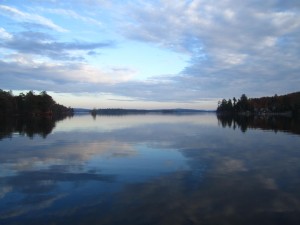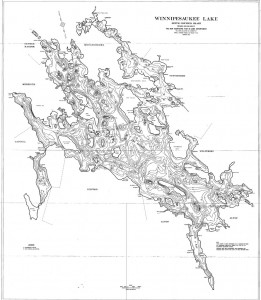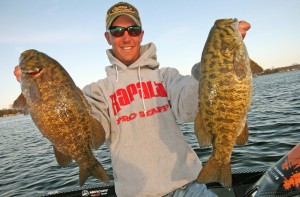How to Catch Bass in Deep Natural Lakes in the Northeast
filed in Bass Fishing Tips on Mar.07, 2016
How to Catch Bass in Deep Natural Lakes in the Northeast

Deep Natural Lakes in the Northeast can be tricky for southern anglers who are used to shallower, dirtier water.
Want to know how to catch bass in deep natural lakes in the Northeast? Read on!
The Northeast United States has an abundance of deep natural lakes that are home to some pretty healthy populations of largemouth and smallmouth bass. For anglers that are native to this area of the country, they usually don’t have much trouble figuring them out. For anglers who are from the south, though, they sometimes struggle figuring out how to catch bass in deep natural lakes in the northeast.
Why does this happen?
In the south, man-made reservoirs rule. Natural lakes are less plentiful and they are very often overlooked. Most anglers tend to gravitate to the large reservoirs due to the sheer abundance of water they offer to fish.
Because of this, almost all of their learning efforts are put into studying and learning how to catch bass in their own local reservoirs, instead of the natural lakes that are also available. After all, the reservoirs have channels, underwater points, ledges, submerged buildings, bridges, old cars and trucks, timber fields, stumps, and much more. The cover and structure they offer is a haven for big bass.
So, what happens when you take a southern angler and put them on a deep natural lake in the northeast? Many times they have a hard time unlocking the secrets of these natural lakes. In turn, they struggle to catch fish consistently. And that can lead to frustration. In some drastic cases, they actually give up trying.
So how can a southern angler who understands the dynamics of reservoir fishing learn how to catch bass in deep natural lakes of the northeast? It’s not as hard or as complicated as it might seem! It just takes a bit of adjustment in thinking and methodology.
So what does it take to catch bass in deep natural lakes in the northeast?
The absolute best advice I can give is to look for natural structure and contours.
Most natural lakes will have points, drop-offs and humps that will hold fish. And some natural lakes will even have some ledges. They just won’t have creek channels. Because creek channels are created by the original river or stream that ran through an area, before it was impounded to create the reservoir, they leave a very defined area that can be used to target bass.
Deep natural lakes will have just about every other kind of structure or cover that reservoirs have. But you may need to look a bit harder to find these places, since the surrounding land might not give as many hints as it would in a reservoir.
So how do you find these places in natural lakes?
Points will be visible by looking at the shoreline. Look for areas that jut out into the water. This is no different than in reservoirs. Points in natural lakes can sometimes be less well defined than points in reservoirs, but this isn’t always the case. And they will still hold fish, even if they’re not as defined.
Remember that fish will relate to and use what’s available to them. They haven’t been to reservoirs and seen the “better” habitat, so they will use what’s available to them in whatever their natural environment is.
Offshore Humps – Invisible Gold Mines
In addition to points, natural lakes can also have offshore humps. Offshore humps can be absolute gold mines, especially if they have any kind of cover on them. Cover types might be various weeds, scattered rocks, etc.
And some humps will have secondary features on them, such as small points or ledges that can be a sweet spot within a sweet spot. These can be difficult to find unless you know someone familiar with a lake or have good electronics that you can use.
The other, more obvious, option is to use lake maps, just as you would for a reservoir. It’s safe to say that all state fish and game departments provide at least rudimentary lake maps for the bodies of water in their respective states.
These maps might not be as detailed as some that you can get for reservoirs, but they can be a lifesaver when you’re trying to learn something about a new lake. Even better, some states actually offer some pretty decent lake maps that can be an immense help.
So, between lake maps, people familiar with a specific lake, and spending time with your electronics, you should have no trouble finding offshore humps to target and catch fish off of.
Drop-offs Exist Here Too!
Drop-offs can also be found by spending time with electronics offshore. They will never be obvious by simply looking at the lake surface. And as with the offshore humps, they can take some time to find. But most lake maps will help you find them. And remember that a drop-off doesn’t have to be drastic to hold fish. Sometimes a drop as little as a foot or two can be a bass magnet.
Bass Love Shallow Water Too
 And never overlook shallow cover. Even though it’s the most obvious cover on the lake and gets heavier pressure than the offshore stuff, it’ll still hold nice fish and can be very rewarding to fish if you spend time learning the subtle nuances and “sweet spots” that can be hidden in plain sight.
And never overlook shallow cover. Even though it’s the most obvious cover on the lake and gets heavier pressure than the offshore stuff, it’ll still hold nice fish and can be very rewarding to fish if you spend time learning the subtle nuances and “sweet spots” that can be hidden in plain sight.
Remember to look for the spot within the spot. Look for changes in bottom content or areas where the weeds change from one species to another. These are both places that indicate some kind of bottom transition. And bottom transitions will hold fish, even in their most subtle forms.
Don’t Let Natural Lakes Deter You
So don’t let the fact that a lake isn’t a reservoir turn you off or intimidate you.
Spend some time finding the areas mentioned above. Once you find those spots, It’s just a matter of figuring out what the bass want, in order to catch them.
And keep in mind the seasonal movements of the bass. This will come into play in a natural lake just as much as it will in reservoirs. There probably won’t be schools of shad for the bass to follow, like they do in reservoirs, but the rising and falling water temperatures will still cause the bass to move with the changing seasons.
So remember, just like reservoirs, time spent studying lake maps and using your electronics to find good bottom contours will pay off with nice catches of big bass in deep natural lake, if you don’t give up.
Fish on! <><
Photo of big smallmouth bass courtesy www.finsntales.com



Leave a Reply
You must be logged in to post a comment.